JEEP GRAND CHEROKEE 2010 Owner handbook (in English)
Manufacturer: JEEP, Model Year: 2010, Model line: GRAND CHEROKEE, Model: JEEP GRAND CHEROKEE 2010Pages: 350, PDF Size: 4.58 MB
Page 121 of 350
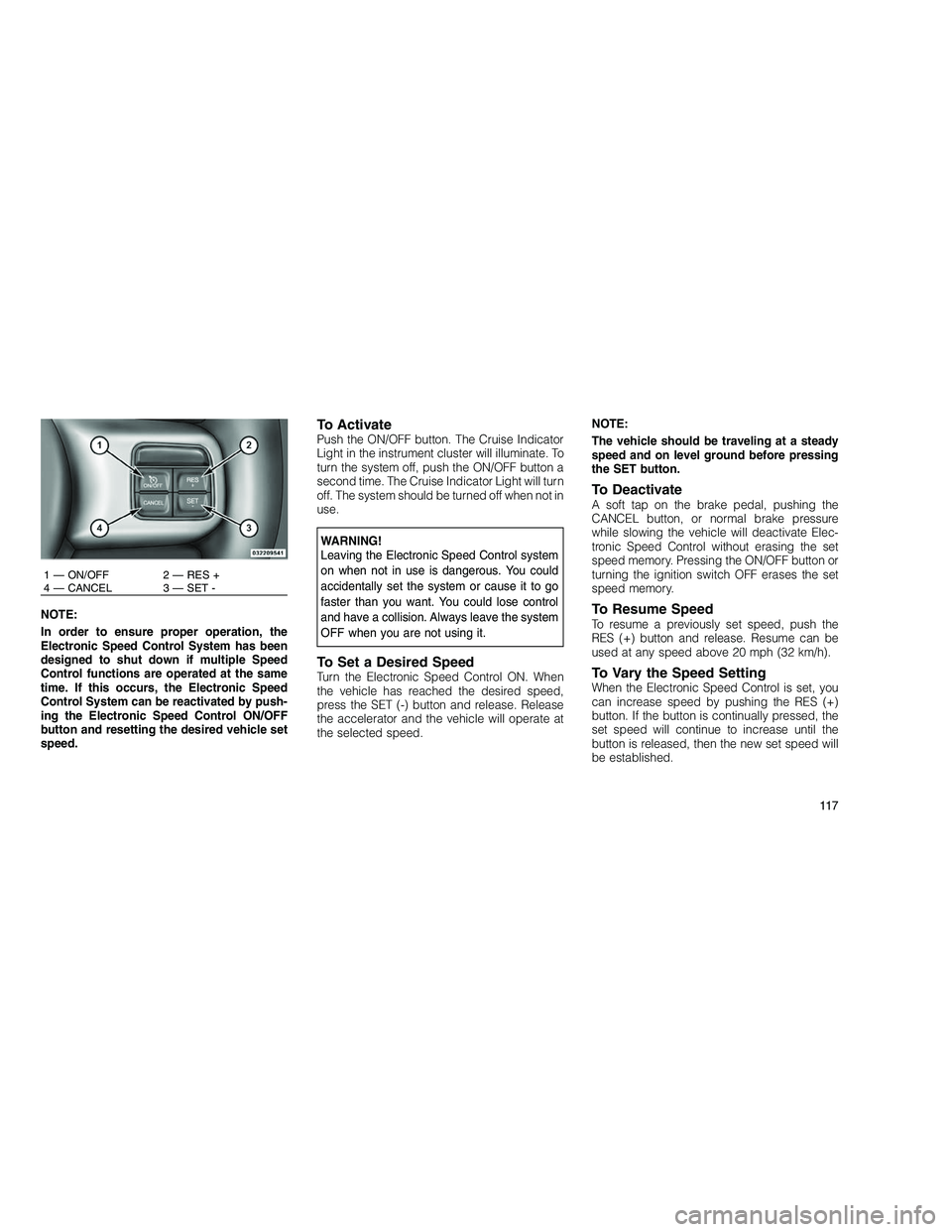
NOTE:
In order to ensure proper operation, the
Electronic Speed Control System has been
designed to shut down if multiple Speed
Control functions are operated at the same
time. If this occurs, the Electronic Speed
Control System can be reactivated by push-
ing the Electronic Speed Control ON/OFF
button and resetting the desired vehicle set
speed.
To ActivatePush the ON/OFF button. The Cruise Indicator
Light in the instrument cluster will illuminate. To
turn the system off, push the ON/OFF button a
second time. The Cruise Indicator Light will turn
off. The system should be turned off when not in
use.
WARNING!
Leaving the Electronic Speed Control system
on when not in use is dangerous. You could
accidentally set the system or cause it to go
faster than you want. You could lose control
and have a collision. Always leave the system
OFF when you are not using it.
To Set a Desired SpeedTurn the Electronic Speed Control ON. When
the vehicle has reached the desired speed,
press the SET (-) button and release. Release
the accelerator and the vehicle will operate at
the selected speed.NOTE:
The vehicle should be traveling at a steady
speed and on level ground before pressing
the SET button.
To DeactivateA soft tap on the brake pedal, pushing the
CANCEL button, or normal brake pressure
while slowing the vehicle will deactivate Elec-
tronic Speed Control without erasing the set
speed memory. Pressing the ON/OFF button or
turning the ignition switch OFF erases the set
speed memory.
To Resume SpeedTo resume a previously set speed, push the
RES (+) button and release. Resume can be
used at any speed above 20 mph (32 km/h).
To Vary the Speed SettingWhen the Electronic Speed Control is set, you
can increase speed by pushing the RES (+)
button. If the button is continually pressed, the
set speed will continue to increase until the
button is released, then the new set speed will
be established.
1 — ON/OFF 2 — RES +
4 — CANCEL 3 — SET -
11 7
Page 122 of 350
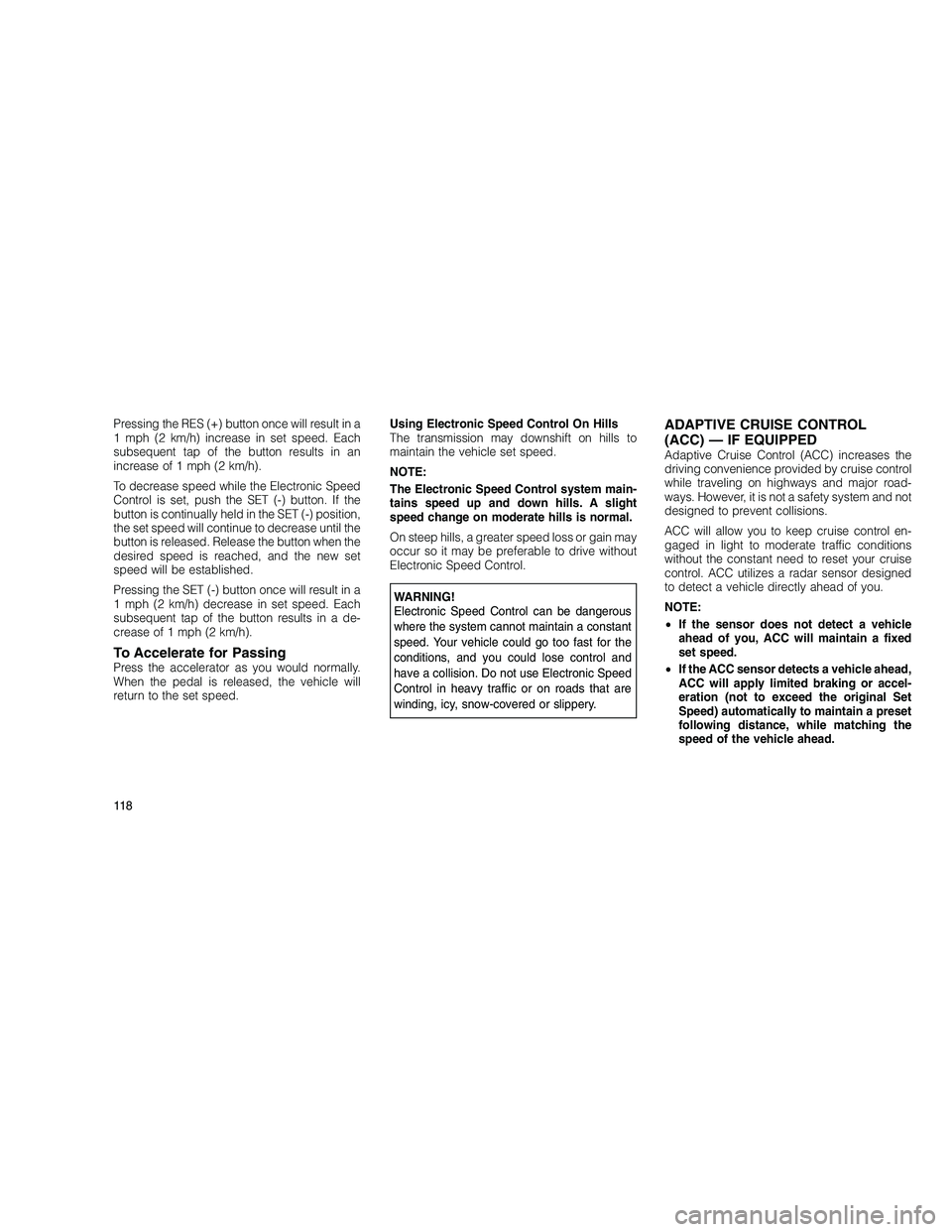
Pressing the RES (+) button once will result in a
1 mph (2 km/h) increase in set speed. Each
subsequent tap of the button results in an
increase of 1 mph (2 km/h).
To decrease speed while the Electronic Speed
Control is set, push the SET (-) button. If the
button is continually held in the SET (-) position,
the set speed will continue to decrease until the
button is released. Release the button when the
desired speed is reached, and the new set
speed will be established.
Pressing the SET (-) button once will result in a
1 mph (2 km/h) decrease in set speed. Each
subsequent tap of the button results in a de-
crease of 1 mph (2 km/h).
To Accelerate for PassingPress the accelerator as you would normally.
When the pedal is released, the vehicle will
return to the set speed.Using Electronic Speed Control On Hills
The transmission may downshift on hills to
maintain the vehicle set speed.
NOTE:
The Electronic Speed Control system main-
tains speed up and down hills. A slight
speed change on moderate hills is normal.
On steep hills, a greater speed loss or gain may
occur so it may be preferable to drive without
Electronic Speed Control.
WARNING!
Electronic Speed Control can be dangerous
where the system cannot maintain a constant
speed. Your vehicle could go too fast for the
conditions, and you could lose control and
have a collision. Do not use Electronic Speed
Control in heavy traffic or on roads that are
winding, icy, snow-covered or slippery.
ADAPTIVE CRUISE CONTROL
(ACC) — IF EQUIPPED
Adaptive Cruise Control (ACC) increases the
driving convenience provided by cruise control
while traveling on highways and major road-
ways. However, it is not a safety system and not
designed to prevent collisions.
ACC will allow you to keep cruise control en-
gaged in light to moderate traffic conditions
without the constant need to reset your cruise
control. ACC utilizes a radar sensor designed
to detect a vehicle directly ahead of you.
NOTE:
•
If the sensor does not detect a vehicle
ahead of you, ACC will maintain a fixed
set speed.
• If the ACC sensor detects a vehicle ahead,
ACC will apply limited braking or accel-
eration (not to exceed the original Set
Speed) automatically to maintain a preset
following distance, while matching the
speed of the vehicle ahead.
11 8
Page 123 of 350
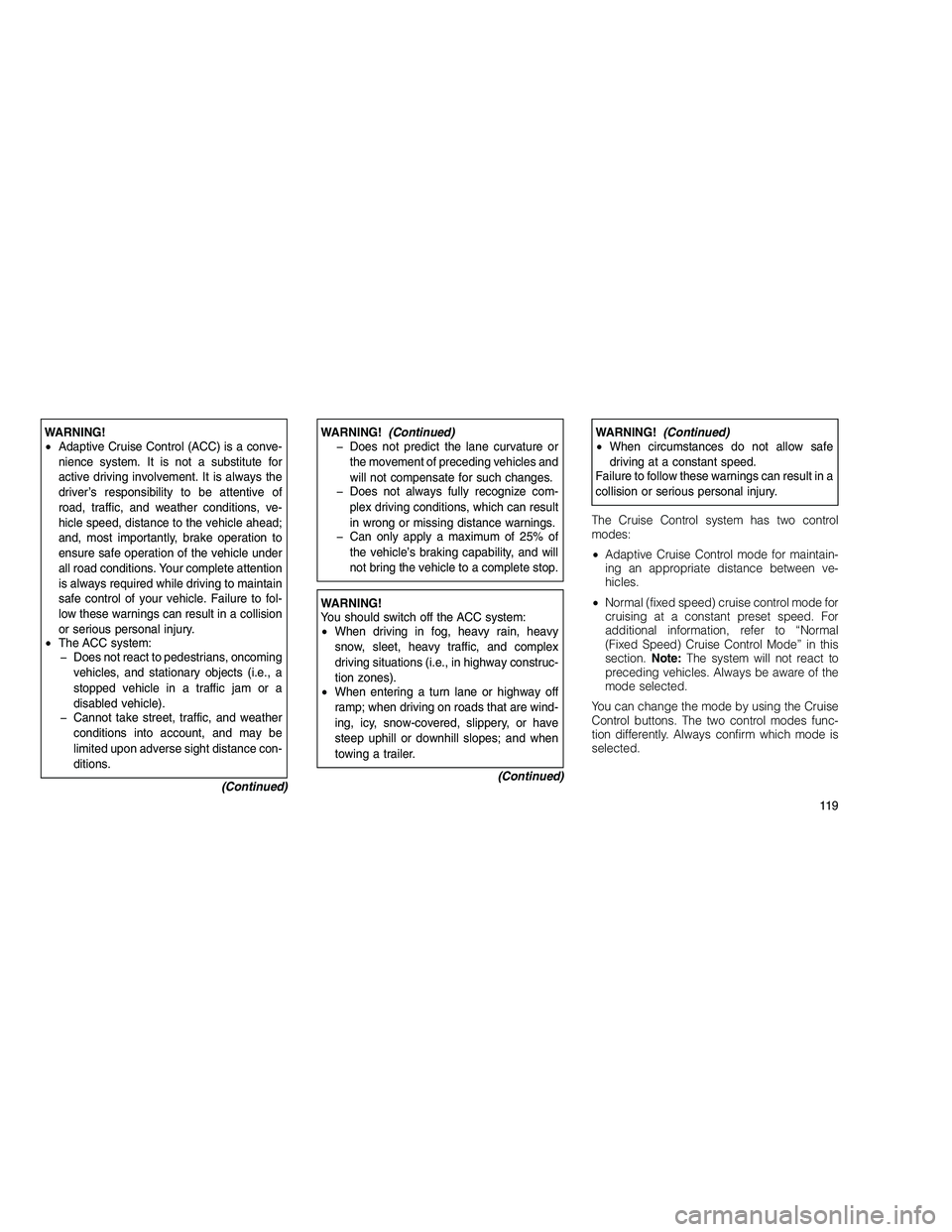
WARNING!
•Adaptive Cruise Control (ACC) is a conve-
nience system. It is not a substitute for
active driving involvement. It is always the
driver’s responsibility to be attentive of
road, traffic, and weather conditions, ve-
hicle speed, distance to the vehicle ahead;
and, most importantly, brake operation to
ensure safe operation of the vehicle under
all road conditions. Your complete attention
is always required while driving to maintain
safe control of your vehicle. Failure to fol-
low these warnings can result in a collision
or serious personal injury.
• The ACC system:
� Does not react to pedestrians, oncoming
vehicles, and stationary objects (i.e., a
stopped vehicle in a traffic jam or a
disabled vehicle).
� Cannot take street, traffic, and weather
conditions into account, and may be
limited upon adverse sight distance con-
ditions.
(Continued)WARNING!(Continued)
� Does not predict the lane curvature or
the movement of preceding vehicles and
will not compensate for such changes.
� Does not always fully recognize com-
plex driving conditions, which can result
in wrong or missing distance warnings.
� Can only apply a maximum of 25% of
the vehicle’s braking capability, and will
not bring the vehicle to a complete stop.
WARNING!
You should switch off the ACC system:
• When driving in fog, heavy rain, heavy
snow, sleet, heavy traffic, and complex
driving situations (i.e., in highway construc-
tion zones).
• When entering a turn lane or highway off
ramp; when driving on roads that are wind-
ing, icy, snow-covered, slippery, or have
steep uphill or downhill slopes; and when
towing a trailer.
(Continued)
WARNING!(Continued)
• When circumstances do not allow safe
driving at a constant speed.
Failure to follow these warnings can result in a
collision or serious personal injury.
The Cruise Control system has two control
modes:
• Adaptive Cruise Control mode for maintain-
ing an appropriate distance between ve-
hicles.
• Normal (fixed speed) cruise control mode for
cruising at a constant preset speed. For
additional information, refer to “Normal
(Fixed Speed) Cruise Control Mode” in this
section. Note:The system will not react to
preceding vehicles. Always be aware of the
mode selected.
You can change the mode by using the Cruise
Control buttons. The two control modes func-
tion differently. Always confirm which mode is
selected.
11 9
Page 124 of 350
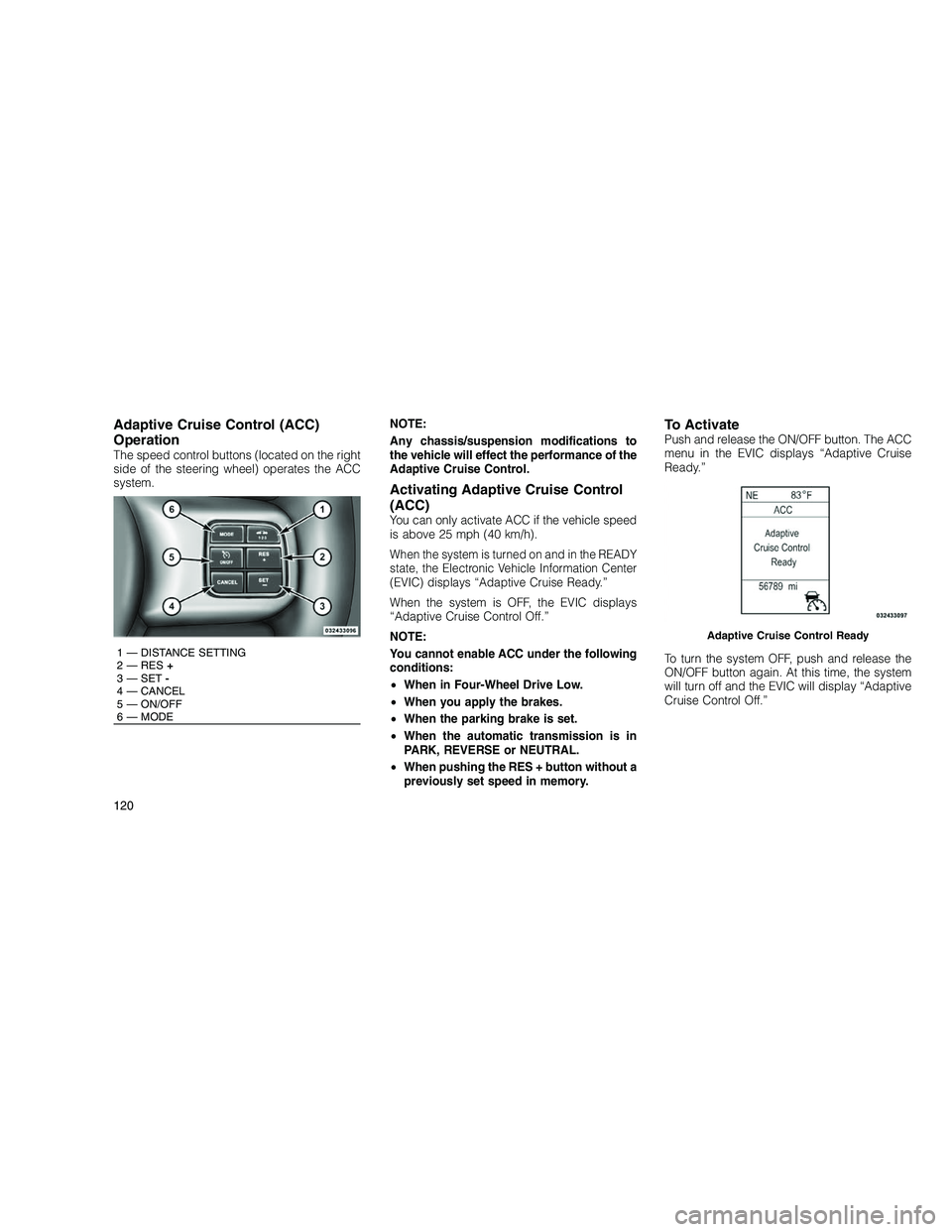
Adaptive Cruise Control (ACC)
Operation
The speed control buttons (located on the right
side of the steering wheel) operates the ACC
system.NOTE:
Any chassis/suspension modifications to
the vehicle will effect the performance of the
Adaptive Cruise Control.
Activating Adaptive Cruise Control
(ACC)
You can only activate ACC if the vehicle speed
is above 25 mph (40 km/h).
When the system is turned on and in the READY
state, the Electronic Vehicle Information Center
(EVIC) displays “Adaptive Cruise Ready.”
When the system is OFF, the EVIC displays
“Adaptive Cruise Control Off.”
NOTE:
You cannot enable ACC under the following
conditions:
•
When in Four-Wheel Drive Low.
• When you apply the brakes.
• When the parking brake is set.
• When the automatic transmission is in
PARK, REVERSE or NEUTRAL.
• When pushing the RES + button without a
previously set speed in memory.
To ActivatePush and release the ON/OFF button. The ACC
menu in the EVIC displays “Adaptive Cruise
Ready.”
To turn the system OFF, push and release the
ON/OFF button again. At this time, the system
will turn off and the EVIC will display “Adaptive
Cruise Control Off.”
1 — DISTANCE SETTING
2 — RES +
3 — SET -
4 — CANCEL
5 — ON/OFF
6 — MODE
Adaptive Cruise Control Ready
120
Page 125 of 350
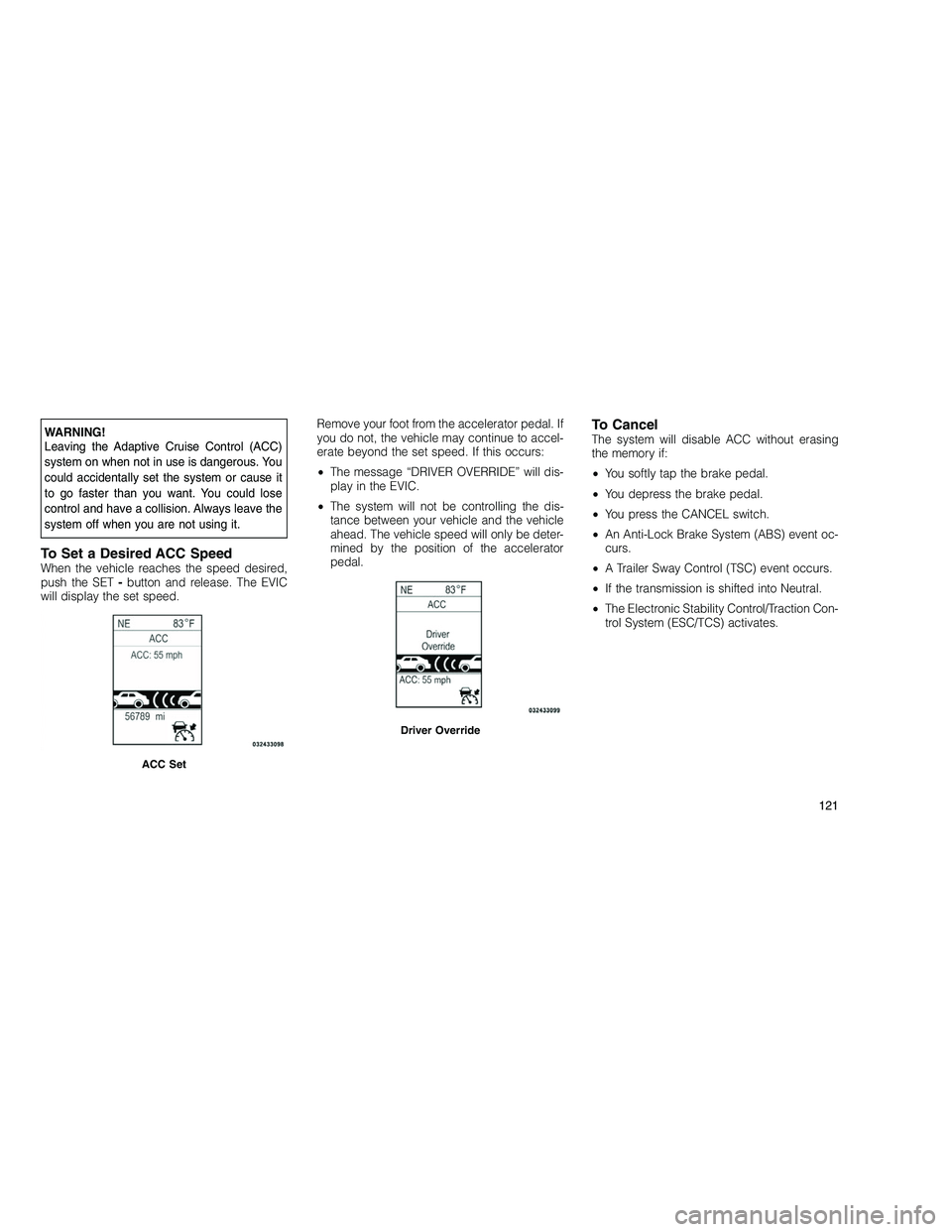
WARNING!
Leaving the Adaptive Cruise Control (ACC)
system on when not in use is dangerous. You
could accidentally set the system or cause it
to go faster than you want. You could lose
control and have a collision. Always leave the
system off when you are not using it.
To Set a Desired ACC SpeedWhen the vehicle reaches the speed desired,
push the SET-button and release. The EVIC
will display the set speed. Remove your foot from the accelerator pedal. If
you do not, the vehicle may continue to accel-
erate beyond the set speed. If this occurs:
•
The message “DRIVER OVERRIDE” will dis-
play in the EVIC.
• The system will not be controlling the dis-
tance between your vehicle and the vehicle
ahead. The vehicle speed will only be deter-
mined by the position of the accelerator
pedal.
To CancelThe system will disable ACC without erasing
the memory if:
• You softly tap the brake pedal.
• You depress the brake pedal.
• You press the CANCEL switch.
• An Anti-Lock Brake System (ABS) event oc-
curs.
• A Trailer Sway Control (TSC) event occurs.
• If the transmission is shifted into Neutral.
• The Electronic Stability Control/Traction Con-
trol System (ESC/TCS) activates.
ACC Set
Driver Override
121
Page 126 of 350
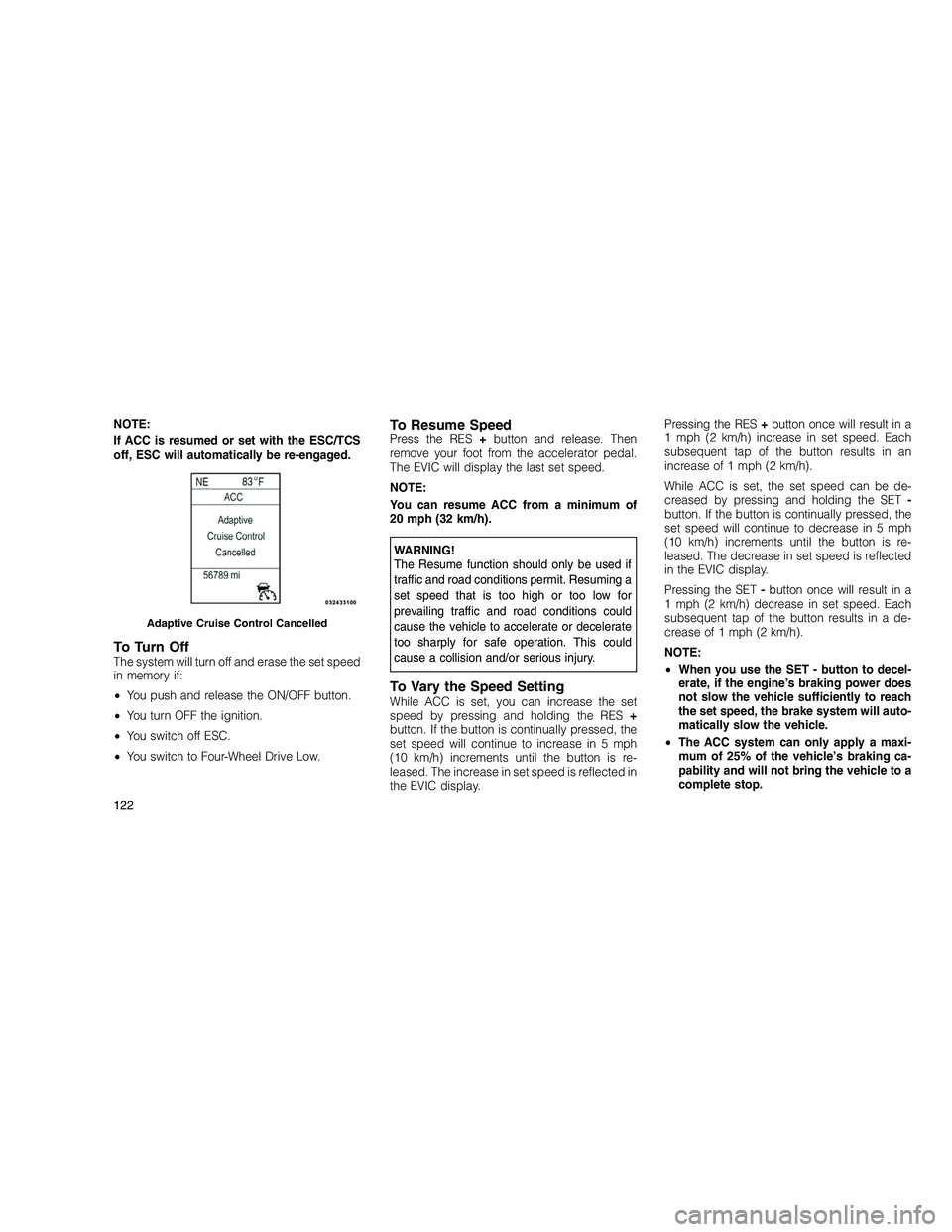
NOTE:
If ACC is resumed or set with the ESC/TCS
off, ESC will automatically be re-engaged.
To Turn OffThe system will turn off and erase the set speed
in memory if:
•You push and release the ON/OFF button.
• You turn OFF the ignition.
• You switch off ESC.
• You switch to Four-Wheel Drive Low.
To Resume SpeedPress the RES +button and release. Then
remove your foot from the accelerator pedal.
The EVIC will display the last set speed.
NOTE:
You can resume ACC from a minimum of
20 mph (32 km/h).
WARNING!
The Resume function should only be used if
traffic and road conditions permit. Resuming a
set speed that is too high or too low for
prevailing traffic and road conditions could
cause the vehicle to accelerate or decelerate
too sharply for safe operation. This could
cause a collision and/or serious injury.
To Vary the Speed SettingWhile ACC is set, you can increase the set
speed by pressing and holding the RES +
button. If the button is continually pressed, the
set speed will continue to increase in 5 mph
(10 km/h) increments until the button is re-
leased. The increase in set speed is reflected in
the EVIC display. Pressing the RES
+button once will result in a
1 mph (2 km/h) increase in set speed. Each
subsequent tap of the button results in an
increase of 1 mph (2 km/h).
While ACC is set, the set speed can be de-
creased by pressing and holding the SET -
button. If the button is continually pressed, the
set speed will continue to decrease in 5 mph
(10 km/h) increments until the button is re-
leased. The decrease in set speed is reflected
in the EVIC display.
Pressing the SET -button once will result in a
1 mph (2 km/h) decrease in set speed. Each
subsequent tap of the button results in a de-
crease of 1 mph (2 km/h).
NOTE:
• When you use the SET - button to decel-
erate, if the engine’s braking power does
not slow the vehicle sufficiently to reach
the set speed, the brake system will auto-
matically slow the vehicle.
• The ACC system can only apply a maxi-
mum of 25% of the vehicle’s braking ca-
pability and will not bring the vehicle to a
complete stop.
Adaptive Cruise Control Cancelled
122
Page 127 of 350
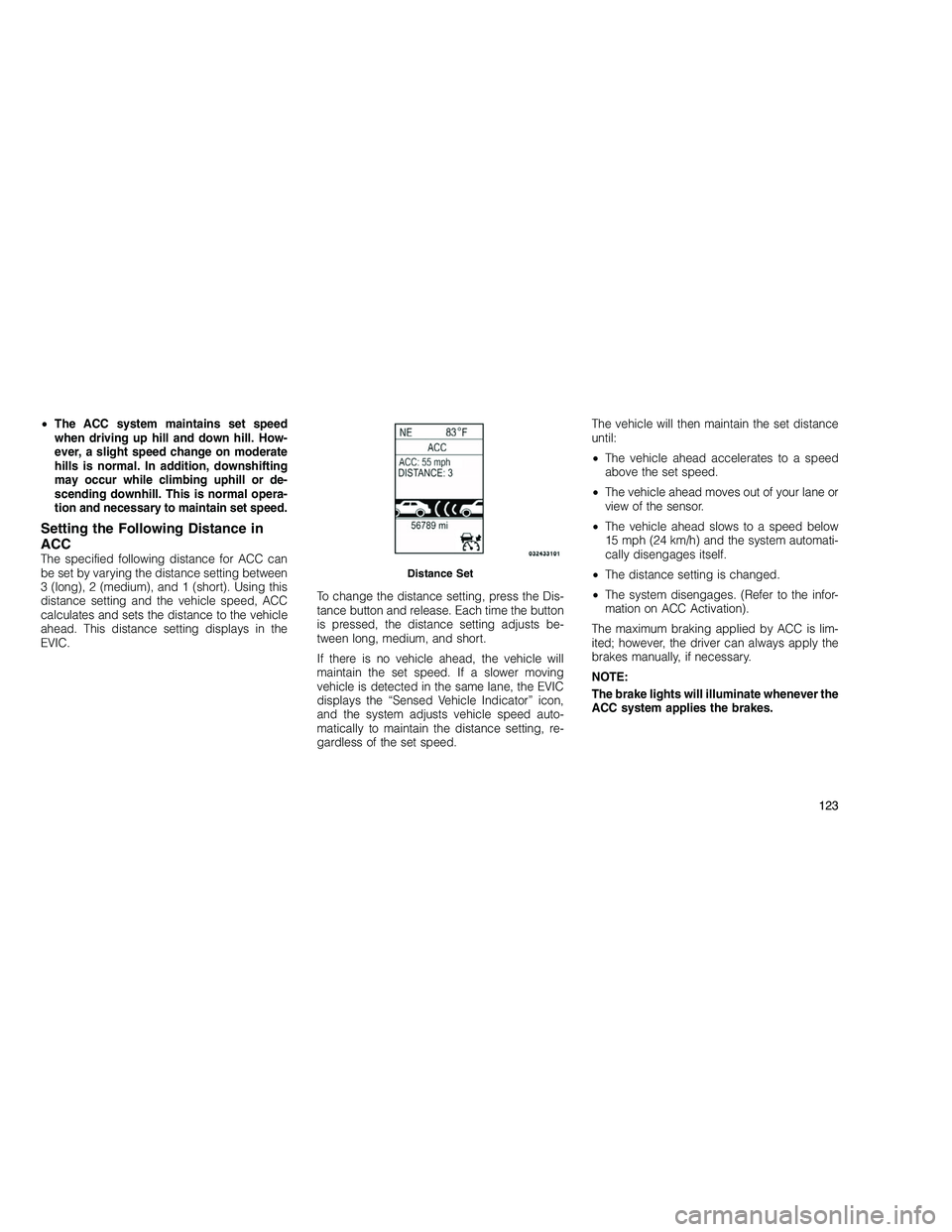
•The ACC system maintains set speed
when driving up hill and down hill. How-
ever, a slight speed change on moderate
hills is normal. In addition, downshifting
may occur while climbing uphill or de-
scending downhill. This is normal opera-
tion and necessary to maintain set speed.
Setting the Following Distance in
ACC
The specified following distance for ACC can
be set by varying the distance setting between
3 (long), 2 (medium), and 1 (short). Using this
distance setting and the vehicle speed, ACC
calculates and sets the distance to the vehicle
ahead. This distance setting displays in the
EVIC. To change the distance setting, press the Dis-
tance button and release. Each time the button
is pressed, the distance setting adjusts be-
tween long, medium, and short.
If there is no vehicle ahead, the vehicle will
maintain the set speed. If a slower moving
vehicle is detected in the same lane, the EVIC
displays the “Sensed Vehicle Indicator” icon,
and the system adjusts vehicle speed auto-
matically to maintain the distance setting, re-
gardless of the set speed.The vehicle will then maintain the set distance
until:
•
The vehicle ahead accelerates to a speed
above the set speed.
• The vehicle ahead moves out of your lane or
view of the sensor.
• The vehicle ahead slows to a speed below
15 mph (24 km/h) and the system automati-
cally disengages itself.
• The distance setting is changed.
• The system disengages. (Refer to the infor-
mation on ACC Activation).
The maximum braking applied by ACC is lim-
ited; however, the driver can always apply the
brakes manually, if necessary.
NOTE:
The brake lights will illuminate whenever the
ACC system applies the brakes.Distance Set
123
Page 128 of 350
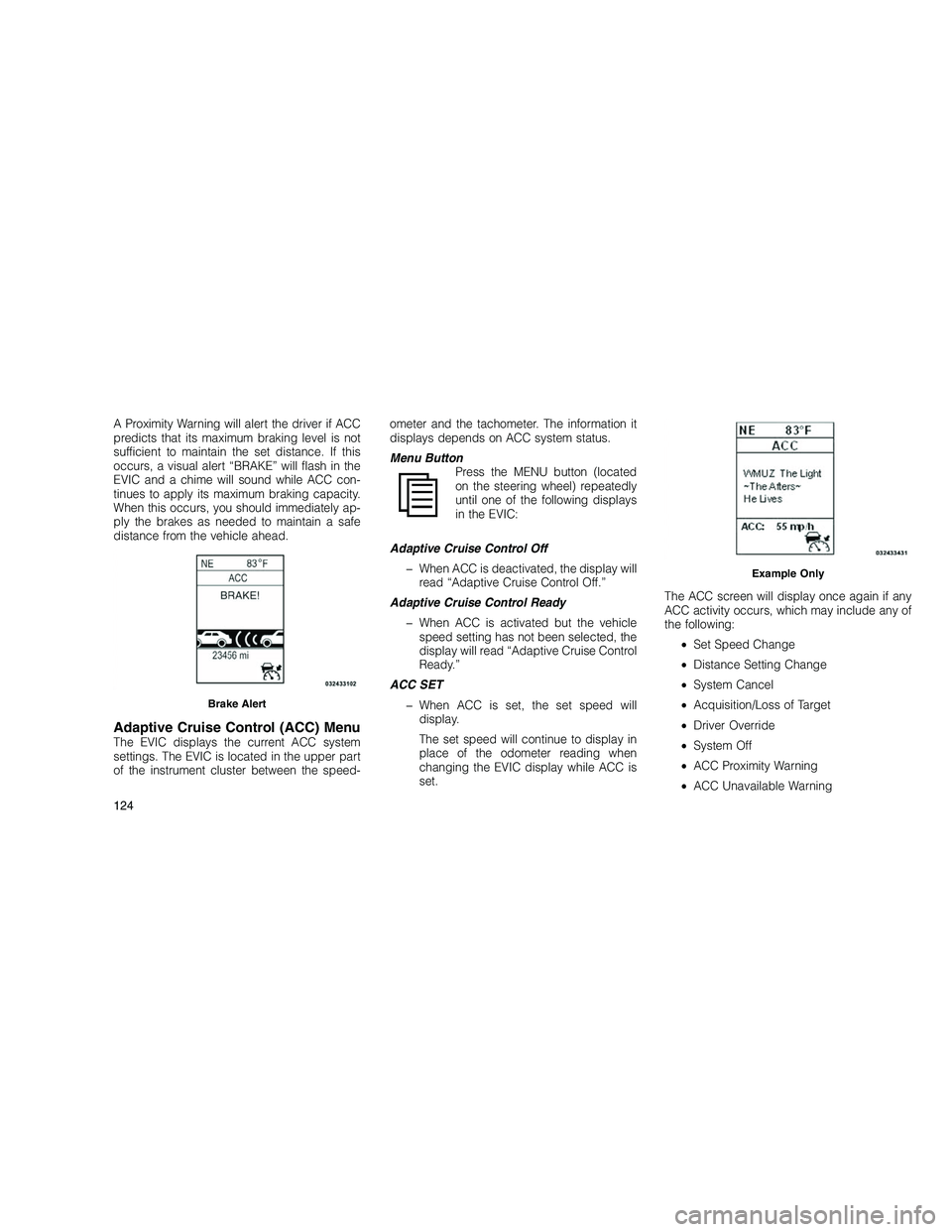
A Proximity Warning will alert the driver if ACC
predicts that its maximum braking level is not
sufficient to maintain the set distance. If this
occurs, a visual alert “BRAKE” will flash in the
EVIC and a chime will sound while ACC con-
tinues to apply its maximum braking capacity.
When this occurs, you should immediately ap-
ply the brakes as needed to maintain a safe
distance from the vehicle ahead.
Adaptive Cruise Control (ACC) MenuThe EVIC displays the current ACC system
settings. The EVIC is located in the upper part
of the instrument cluster between the speed-ometer and the tachometer. The information it
displays depends on ACC system status.
Menu Button
Press the MENU button (located
on the steering wheel) repeatedly
until one of the following displays
in the EVIC:
Adaptive Cruise Control Off � When ACC is deactivated, the display willread “Adaptive Cruise Control Off.”
Adaptive Cruise Control Ready � When ACC is activated but the vehiclespeed setting has not been selected, the
display will read “Adaptive Cruise Control
Ready.”
ACC SET � When ACC is set, the set speed willdisplay.
The set speed will continue to display in
place of the odometer reading when
changing the EVIC display while ACC is
set. The ACC screen will display once again if any
ACC activity occurs, which may include any of
the following:
•Set Speed Change
• Distance Setting Change
• System Cancel
• Acquisition/Loss of Target
• Driver Override
• System Off
• ACC Proximity Warning
• ACC Unavailable Warning
Brake Alert
Example Only
124
Page 129 of 350
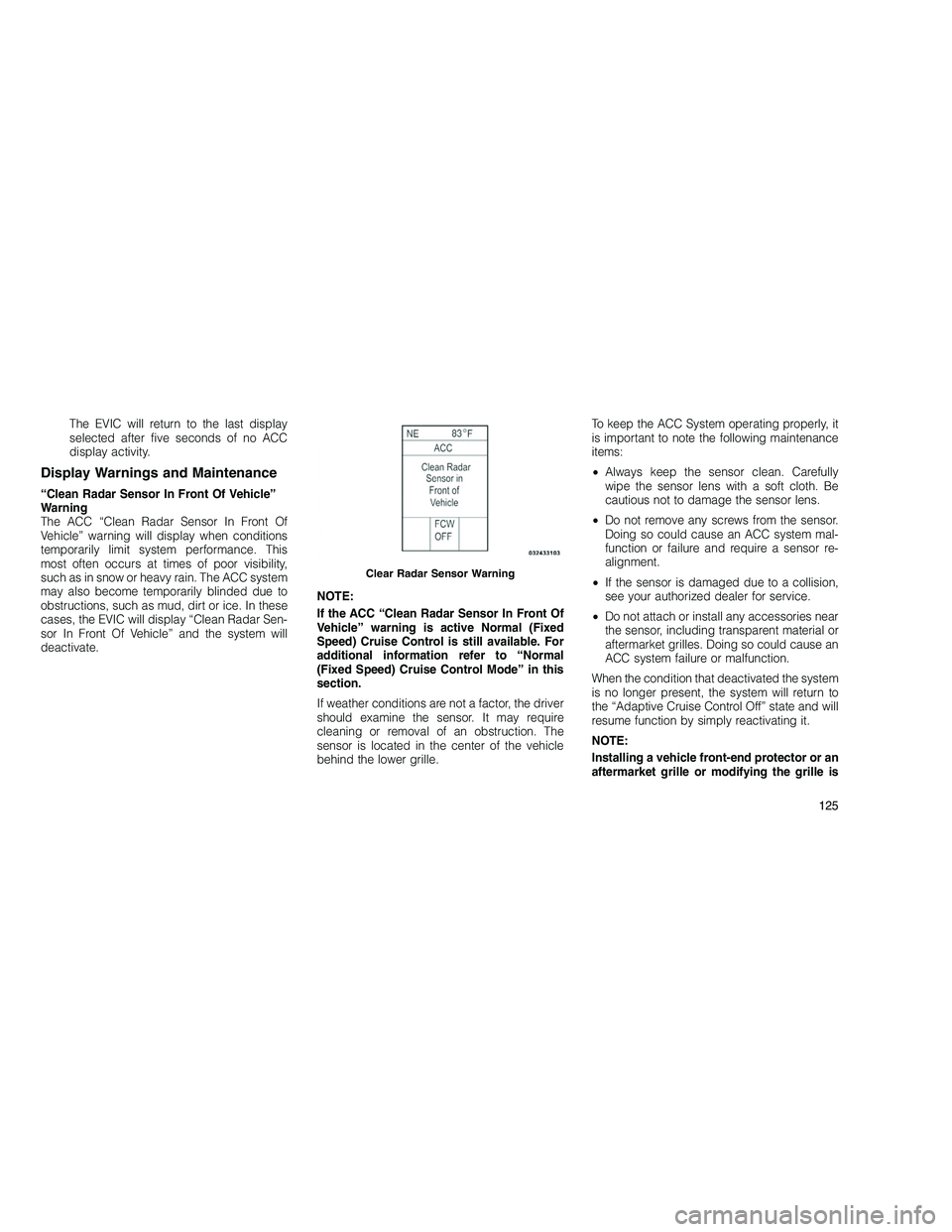
The EVIC will return to the last display
selected after five seconds of no ACC
display activity.
Display Warnings and Maintenance
“Clean Radar Sensor In Front Of Vehicle”
Warning
The ACC “Clean Radar Sensor In Front Of
Vehicle” warning will display when conditions
temporarily limit system performance. This
most often occurs at times of poor visibility,
such as in snow or heavy rain. The ACC system
may also become temporarily blinded due to
obstructions, such as mud, dirt or ice. In these
cases, the EVIC will display “Clean Radar Sen-
sor In Front Of Vehicle” and the system will
deactivate.NOTE:
If the ACC “Clean Radar Sensor In Front Of
Vehicle” warning is active Normal (Fixed
Speed) Cruise Control is still available. For
additional information refer to “Normal
(Fixed Speed) Cruise Control Mode” in this
section.
If weather conditions are not a factor, the driver
should examine the sensor. It may require
cleaning or removal of an obstruction. The
sensor is located in the center of the vehicle
behind the lower grille.To keep the ACC System operating properly, it
is important to note the following maintenance
items:
•
Always keep the sensor clean. Carefully
wipe the sensor lens with a soft cloth. Be
cautious not to damage the sensor lens.
• Do not remove any screws from the sensor.
Doing so could cause an ACC system mal-
function or failure and require a sensor re-
alignment.
• If the sensor is damaged due to a collision,
see your authorized dealer for service.
• Do not attach or install any accessories near
the sensor, including transparent material or
aftermarket grilles. Doing so could cause an
ACC system failure or malfunction.
When the condition that deactivated the system
is no longer present, the system will return to
the “Adaptive Cruise Control Off” state and will
resume function by simply reactivating it.
NOTE:
Installing a vehicle front-end protector or an
aftermarket grille or modifying the grille is
Clear Radar Sensor Warning
125
Page 130 of 350
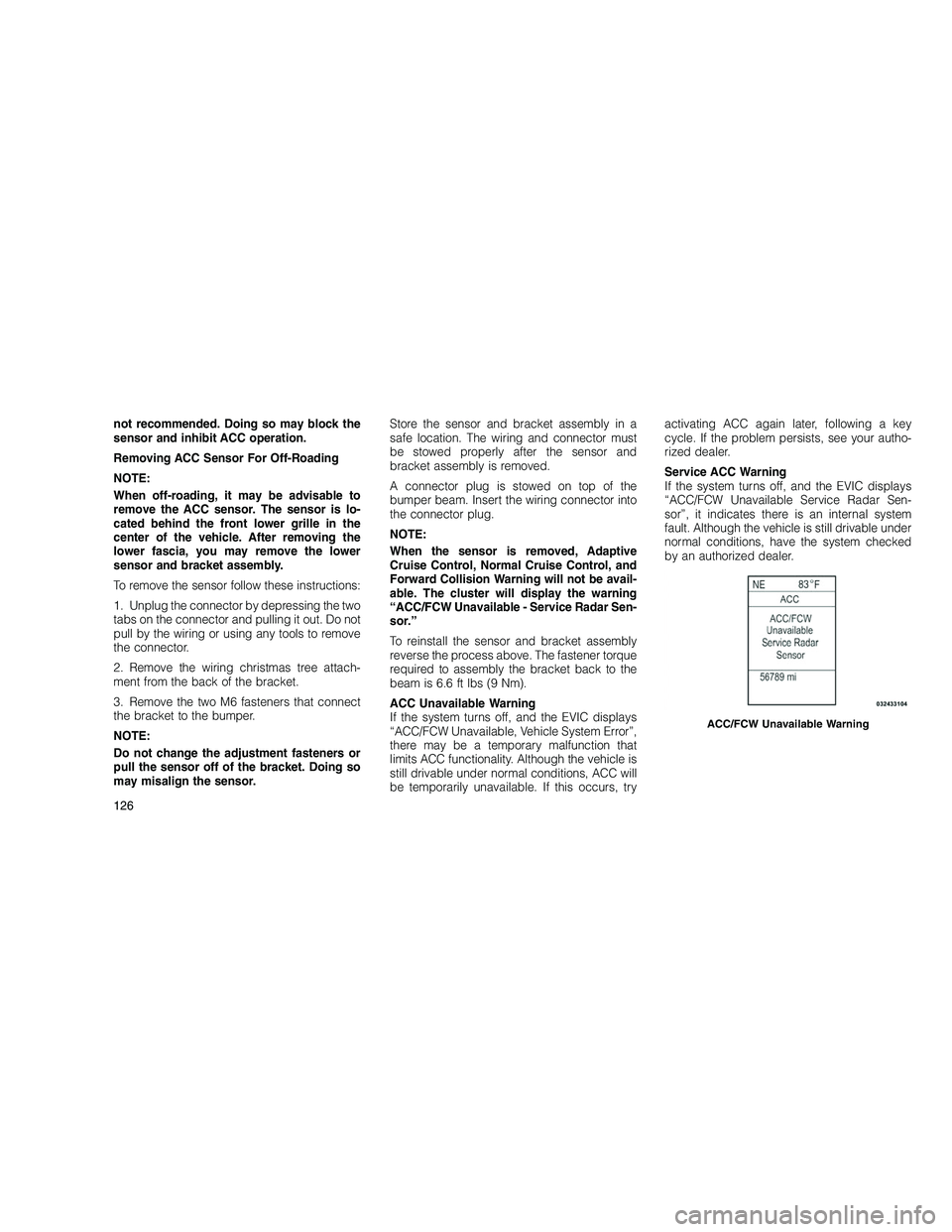
not recommended. Doing so may block the
sensor and inhibit ACC operation.
Removing ACC Sensor For Off-Roading
NOTE:
When off-roading, it may be advisable to
remove the ACC sensor. The sensor is lo-
cated behind the front lower grille in the
center of the vehicle. After removing the
lower fascia, you may remove the lower
sensor and bracket assembly.
To remove the sensor follow these instructions:
1. Unplug the connector by depressing the two
tabs on the connector and pulling it out. Do not
pull by the wiring or using any tools to remove
the connector.
2. Remove the wiring christmas tree attach-
ment from the back of the bracket.
3. Remove the two M6 fasteners that connect
the bracket to the bumper.
NOTE:
Do not change the adjustment fasteners or
pull the sensor off of the bracket. Doing so
may misalign the sensor.Store the sensor and bracket assembly in a
safe location. The wiring and connector must
be stowed properly after the sensor and
bracket assembly is removed.
A connector plug is stowed on top of the
bumper beam. Insert the wiring connector into
the connector plug.
NOTE:
When the sensor is removed, Adaptive
Cruise Control, Normal Cruise Control, and
Forward Collision Warning will not be avail-
able. The cluster will display the warning
“ACC/FCW Unavailable - Service Radar Sen-
sor.”
To reinstall the sensor and bracket assembly
reverse the process above. The fastener torque
required to assembly the bracket back to the
beam is 6.6 ft lbs (9 Nm).
ACC Unavailable Warning
If the system turns off, and the EVIC displays
“ACC/FCW Unavailable, Vehicle System Error”,
there may be a temporary malfunction that
limits ACC functionality. Although the vehicle is
still drivable under normal conditions, ACC will
be temporarily unavailable. If this occurs, tryactivating ACC again later, following a key
cycle. If the problem persists, see your autho-
rized dealer.
Service ACC Warning
If the system turns off, and the EVIC displays
“ACC/FCW Unavailable Service Radar Sen-
sor”, it indicates there is an internal system
fault. Although the vehicle is still drivable under
normal conditions, have the system checked
by an authorized dealer.
ACC/FCW Unavailable Warning
126